
Version: 9.4.5.v20170502
 Version: 9.4.5.v20170502 |
private support for your internal/customer projects ... custom extensions and distributions ... versioned snapshots for indefinite support ... scalability guidance for your apps and Ajax/Comet projects ... development services for sponsored feature development
Table of Contents
General items related to the architecture of jetty and how it deals with certain design decisions.
The Jetty Server is the plumbing between a collection of `Connector`s that accept connections and a collection of `Handler`s that service requests from the connections and produce responses, with threads from a thread pool doing the work.
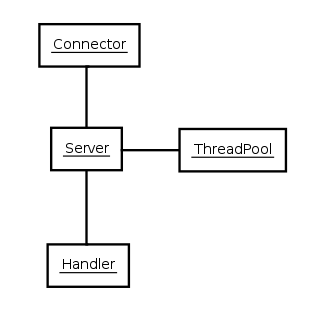
While the Jetty request/responses are derived from the Servlet API, the full features of the Servlet API
are only available if you configure the appropriate handlers.
For example, the session API on the request is inactive unless the request has been passed to a SessionHandler.
The concept of a Servlet itself is implemented by a ServletHandler.
If Servlets are not required, there is very little overhead in the use of the servlet request/response APIs.
Thus you can build a Jetty server using only connectors and handlers, without using Servlets.
The job of configuring Jetty is building a tree of connectors and handlers and providing their individual configurations. As Jetty components are simply Plain Old Java Objects (POJOs), you can accomplish this assembly and configuration of components by a variety of techniques:
The implementation of Jetty follows some fairly standard patterns.
Most abstract concepts such as Connector`s and `Handler`s are captured by interfaces.
Generic handling for those interfaces is then provided in an abstract implementation
such as `AbstractConnector and AbstractHandler.
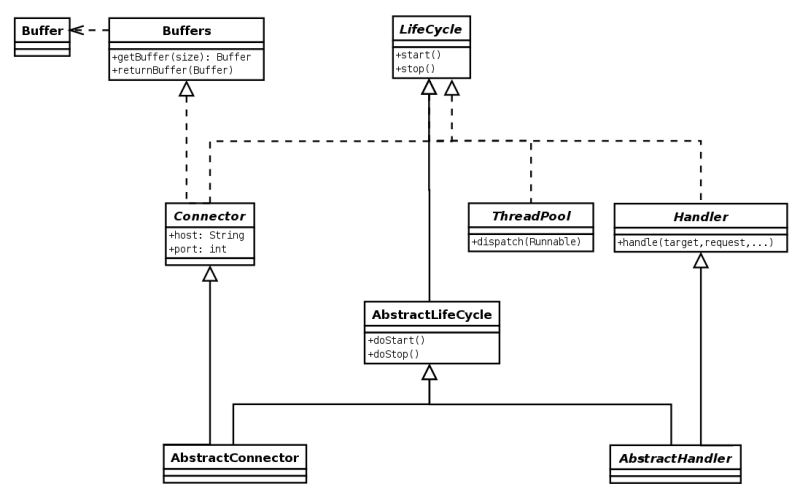
The JSR77 inspired life cycle of most Jetty components is represented by the LifeCycle
interface and the AbstractLifeCycle implementation used as the base of many Jetty components.
A Connector is the component that accepts TCP connections.
For each accepted TCP connection, the Connector asks a ConnectionFactory to create
a Connection object that handles the network traffic on that TCP connection, parsing
and generating bytes for a specific protocol.
A ServerConnector can therefore be configured with one or more ConnectionFactory.
The simplest case is a single ConnectionFactory such as HttpConnectionFactory, that
creates HttpConnection objects that parse and generate bytes for the HTTP/1.1 protocol.
A more complex case can be a ServerConnector configured with three factories:
ProxyConnectionFactory, SslConnectionFactory and HttpConnectionFactory.
Such connector will be able to handle PROXY protocol bytes coming from a load balancer
such as HAProxy (with the ProxyConnectionFactory), then handle TLS bytes (with
SslConnectionFactory) and therefore decrypting/encrypting the bytes from/to a remote
client, and finally handling HTTP/1.1 bytes (with HttpConnectionFactory).
Each ConnectionFactory is asked to create a Connection object for each TCP connection;
the Connection objects will be chained together to handle the bytes, each for its
own protocol.
Therefore the ProxyConnection will handle the PROXY protocol bytes, SslConnection
will handle the encryption/decryption of the bytes, and HttpConnection will handle
the HTTP/1.1 bytes producing a request and response object that will be processed by
applications.
Advanced usages of Jetty will allow users to write their own ConnectionFactory to
handle custom protocols that are not implemented directly by the Jetty project,
therefore using Jetty as a generic network server.
A Handler is the component that deals with HTTP requests and responses.
The core API of a handler is the handle method:
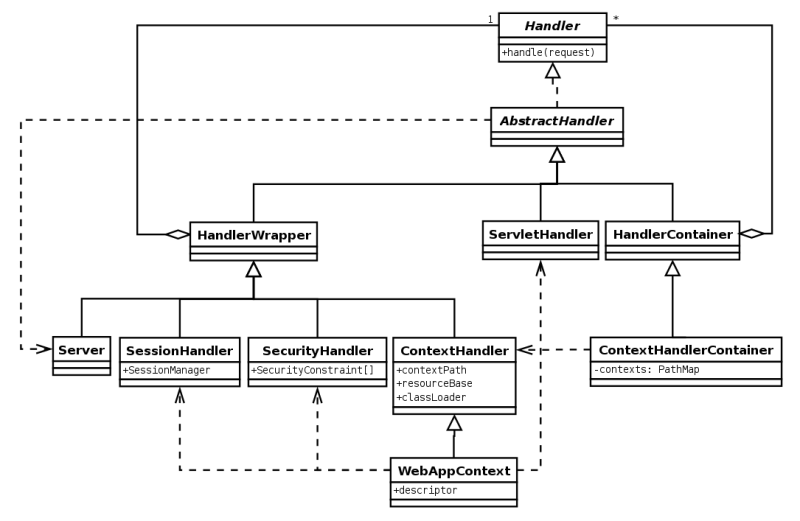
public void handle(String target, Request baseRequest, HttpServletRequest request, HttpServletResponse response) throws IOException, ServletExceptionParameters:
target – the target of the request, either a URI or a name.baseRequest – the original unwrapped request object.request – the request object, either as the baseRequest object or a wrapper of baseRequest.
You can use the HttpConnection.getCurrentConnection() method to access the Request object if required.Response or a wrapper of that response.
You can use the HttpConnection.getCurrentConnection() method to access the Response object if required.An implementation of this method can handle the request, pass the request onto another handler (or servlet) or it might modify and/or wrap the request and then pass it on. This gives three styles of Handler:
HandlerCollection, ContextHandlerCollection)HandlerWrapper, ContextHandler, SessionHandler)ResourceHandler and ServletHandler)You can combine handlers to handle different aspects of a request by nesting them, calling them in sequence, or by combining the two models.
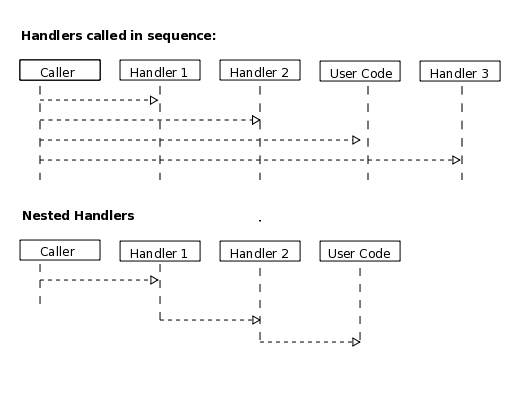
Handlers called in sequence perform actions that do not depend on the next invocation, nor on the handler order.
They handle a request and generate the response without interacting with other handlers.
The main class for this model is HandlerCollection.
Nested handlers are called according to a before/invokeNext/after pattern.
The main class for nested handlers is HandlerWrapper.
Nested handlers are much more common than those called in sequence.
See also Writing Custom Handlers.
The ServletHandler is a Handler that generates content by passing the request to any
configured Servlet Filters and then to a Servlet mapped by a URI pattern.
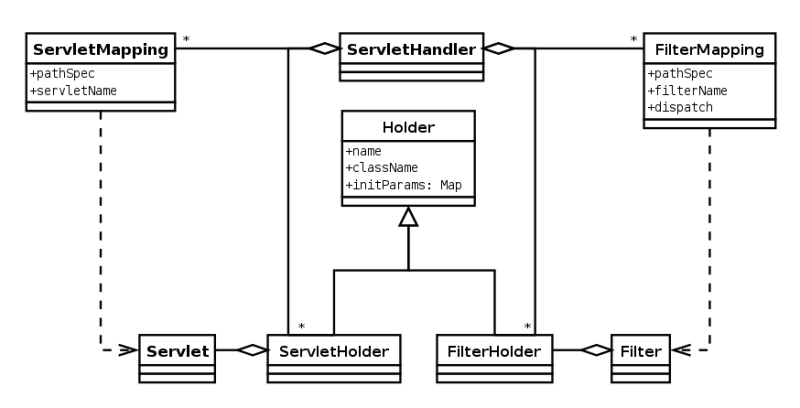
A ServletHandler is normally deployed within the scope of a ServletContext, which is a
ContextHandler that provides convenience methods for mapping URIs to servlets.
Filters and Servlets can also use a RequestDispatcher to reroute a request to another context
or another Servlet in the current context.
Contexts are handlers that group other handlers below a particular URI context path or a virtual host. Typically a context can have:
/myapp)/WEB-INF/classes and /WEB-INF/lib)Contexts implementations include:
ContextHandlerServletContextHandlerWebAppContextA web application context combines handlers for security, session and servlets in a single unit
that you can configure with a web.xml descriptor.
A WebAppContext is a derivation of ServletContextHandler that supports the standardized layout
of a web application and configuration of session, security, listeners, filter, servlets, and JSP
via a web.xml descriptor normally found in the /WEB-INF directory of a web application.
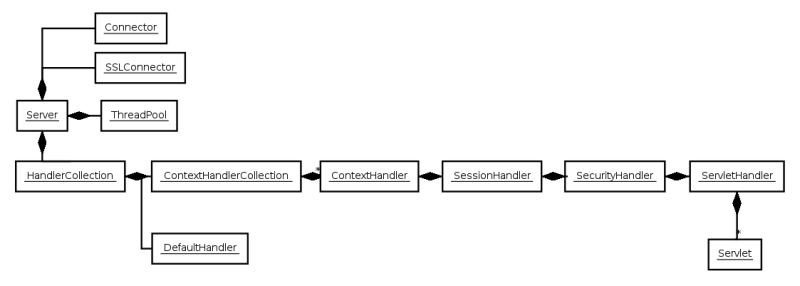
Essentially WebAppContext is a convenience class that assists the construction and configuration
of other handlers to achieve a standard web application configuration.
Configuration is actually done by pluggable implementations of the Configuration class and the
prime among these is WebXmlConfiguration.